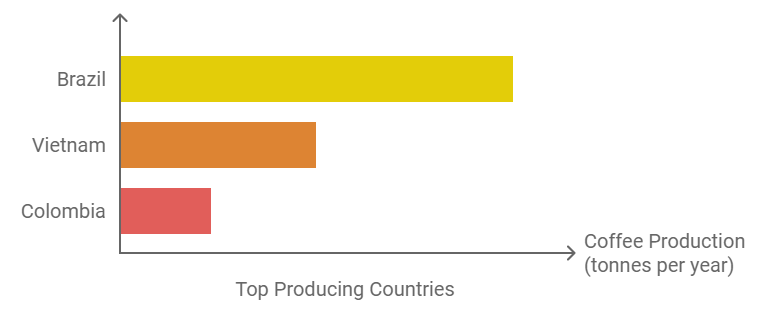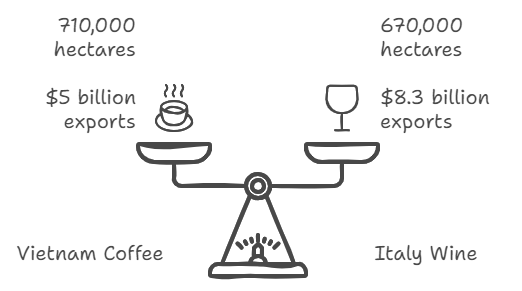
Recently, I’ve been spending more time in Vietnam, and one thing that stood out to me is just how much coffee people drink here. Cafes are everywhere, and coffee is a big part of daily life. Naturally, I assumed that most of the coffee came from regions like South America or Africa. But when I dug deeper, I discovered something surprising.
It turns out that Vietnam is the second-largest coffee producer in the world!
Here’s a look at the top three countries:
- Brazil, around 3.6 million tonnes of coffee per year.
- Vietnam, about 1.8 million tonnes annually.
- Colombia, roughly 840,000 tonnes per year.

I never expected Vietnam to rank so high, but their coffee production is huge!
However, as I learned more, I discovered that coffee, like many other global products, is facing serious challenges—challenges that could impact not just Vietnam but the entire coffee industry worldwide.
Is Coffee Drinking Sustainable?
As I continued my research, I came across a serious issue: the global habit of drinking coffee, something many of us enjoy daily, may soon face sustainability challenges. The numbers speak for themselves:
- 2.25 billion cups of coffee are consumed globally every day!
- Yet, the average coffee tree produces just 1 pound of roasted coffee a year.
This raised a key question: how can the coffee industry keep up with such high demand while dealing with production challenges?
Here are the three major factors that I discovered:
- Rising Coffee Demand: Coffee consumption is growing rapidly, especially in emerging markets.
- Decreasing Production: Climate change is hitting coffee-growing regions hard. Rising temperatures, unpredictable rainfall, and pests are reducing yields in major coffee producers like Brazil, Colombia, and Ethiopia.
- Surging Prices: With lower production and higher demand, coffee prices are climbing. In fact, in 2024, coffee prices hit their highest point in nearly a decade.

Vietnam’s Role in the Coffee World
As one of the world’s largest coffee producers, Vietnam is also feeling the pressure. The Ministry of Agriculture and Rural Development (MARD) reported that in 2023, Vietnam’s coffee exports topped, with around 1.8 million tonnes harvested from over 710,000 hectares of farmland.
Yet, even in Vietnam, coffee prices are rising. In early 2023, coffee was selling for about $2.6 USD per kilo, but by 2024, it had jumped to $4.7 USD per kilo, largely due to global supply shortages and drought.
This got me thinking: the challenges facing coffee are not unique. In fact, other industries, like wine, share many similarities when it comes to global production and consumption trends.

A Surprising Parallel: Coffee and Wine
As someone deeply involved in the Italian wine world, I couldn’t help but notice an interesting parallel between Vietnam’s coffee industry and Italy’s wine industry.
- Just like Vietnam is a major coffee exporter, Italy is a leading wine exporter. In 2023, Italy’s wine exports were valued at around $8.3 billion USD, while Vietnam’s coffee exports reached $5 billion USD.
- In addition, Italy’s vineyards cover approximately 670,000 hectares, which is comparable to the size of Vietnam’s coffee plantations, spanning 710,000 hectares.
Both coffee and wine are essential parts of their respective cultures, yet both industries are facing similar global challenges. Climate change, rising demand, and shifting market dynamics are affecting not just coffee but wine as well.



Very insightful! Thank you Vito.
I’m deeply honored and humbled that my mentor took the time to comment on my modest blog.